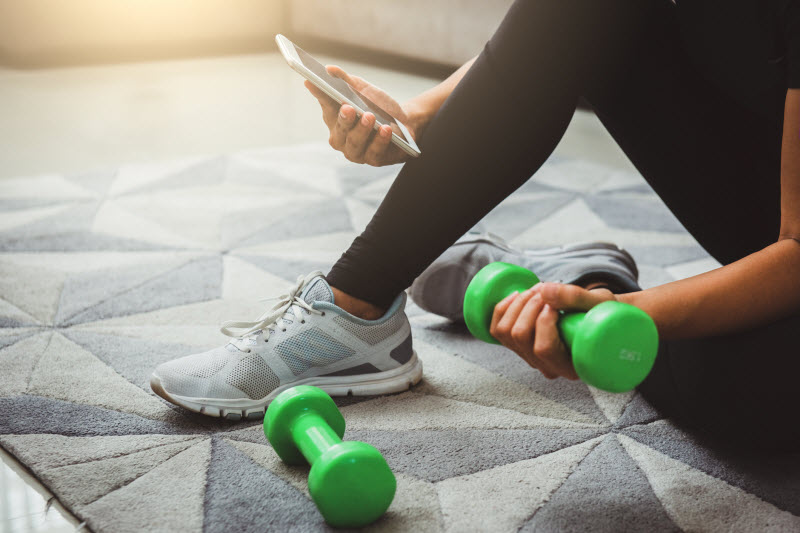Doing a full-body dumbbell workout at home is more common than ever. In fact, the use of portable fitness equipment has increased by almost 50 percent over the last year, according to a poll from
RunRepeat. Not only does this give you more options to move your body outside the gym, but free weights help to intensify muscle resistance when performing various full-body workout repetitions.

Experts from the
National Institutes of Health agree that most healthy adults will benefit from
resistance training at least two days a week. These exercises build muscle strength, joint flexibility, core balance and bone density. Resistance training can also lower the risk factors of diabetes, heart disease and other chronic illnesses, the NIH points out.
Dumbbells are integral to many resistance workouts thanks to their effectiveness and convenience. The compact, portable size of these weights makes them ideal for at-home use, and their versatile function means you can achieve full-body results.
It’s a common misconception that dumbbells are just for arm exercises, but the good news is, you can actually use dumbbells to target a number of different muscle groups, from your glutes to your core. Find out how and start using dumbbells so you can have more effective home workouts.
Full-body health benefits of using dumbbells
Despite the many equipment options available, dumbbells remain one of the most important and valuable tools.
Pete McCall, ACE-certified personal trainer, explains:
“Dumbbells are often used for joint-isolation exercises such as bicep curls, chest flyes or shoulder raises. Using dumbbells for full-body, multiplanar movements, however, can provide a variety of different strength outcomes.”
McCall identifies a variety of benefits of exercising with dumbbells, including:
The weight and resistance that dumbbells yield can promote muscle growth in the form of mechanical and metabolic overload. Mechanic overload occurs when the muscle fibers that were torn during exercise contractions are repaired. Similarly, metabolic overload occurs when the muscles are exerted to the point of fatigue. Both of these outcomes will increase your muscle size.
The full range-of-motion that dumbbell exercises activate can lead to more join stabilization and muscular coordination. Using dumbbells in conjunction with exercises that work the body on various planes of movement (E. forward, lateral and backward lunges) activates different muscle groups simultaneously. This will promote balance, coordination and stability in all areas of the body.
The force that dumbbells exert on the connective tissues can help to boost their flexibility, resilience and elasticity. As the muscle fibers both lengthen and contract with each weight-bearing motion, this force production from the dumbbells helps your tissues become more elastic and resilient. So the more resistance training you perform, the more you’ll notice improvements in flexibility.
Keep in mind, these health and fitness benefits extend to the whole body—not just isolated areas such as the arms. While you might associate dumbbells primarily with bicep curls, shoulder raises, tricep extensions and other upper-body workouts, dumbbells can be just as effective for the core and lower-body too.
With the use of dumbbells, you can increase the weight load on abdominal exercises, like with Russian twists or side plank raises and add arm resistance by doing shoulder presses with squats.
In addition, since most lower-body dumbbell workouts incorporate unilateral—rather than bilateral—movements, the repetitions will be more of a challenge, says
Sivan Fagan, certified personal trainer. Unilateral exercises activate one side of the body at a time, which increases the amount of resistance on your muscles. This causes them to work harder and, as a result, become stronger.
Types of dumbbells—and how to choose
There are three primary dumbbells to choose from: fixed, adjustable or studio. When determining which of these models is the best option for you, think about the price you’re willing to spend, how much space you have to store the weights, and your specific
fitness goals.
Fixed dumbbells
Fixed dumbbells have a consistent weight (I.E. 10, 15 or 20 pounds). This means, if you want to exercise with a variety of different weights, you need to purchase multiple sets of dumbbells. The cost to own fixed dumbbells can be expensive and inconvenient if you don’t have much storage room. Once you make the investment, however, fixed dumbbells can last for a long time since they’re built with durable material.
Adjustable dumbbells
Adjustable dumbbells allow you to change the amount of weight manually on just one piece of equipment, rather than having to keep multiple sets of dumbbells. These dumbbells come with a metal bar and a series of weighted plates that you either add or remove based on the heaviness you want to lift. This model is also expensive, but with its streamlined, compact, multi-functional design, an adjustable dumbbell is the equivalent of a whole set of fixed weights in one, making it easy to store.
Studio dumbbells
Studio dumbbells are both small and lightweight which makes them better suited for cardio and resistance interval training circuits. Most of these dumbbells range from around 2 to 10 pounds and they’re made with a rubber or vinyl coating, which makes them slip resistant. It’s also worth mentioning that studio dumbbells are often less expensive than the other two dumbbell varieties, making them a good place to start for newbies.
Full-Body Dumbbell Workout
If you’re ready to try your weights at home, but aren’t sure what exercises to do, try this sequence. Perform each exercise for 10 to 15 reps, completing 3 to 5 sets total. The more sets and reps, the more challenging the workout.
Woodchucks
Stand with feet shoulder width apart, holding your dumbbell on either side so it’s horizontal in front of you. Lower into a slight squat, bring the weight over to your right hip, brace your core, and swing it in front of your body adn over your left shoulder—like you’re throwing something behind you. Keep your core tight as you return to start and repeat, doing all reps on one side before switching to the other.
Front Raises
Stand with feet shoulder width apart holding a dumbbell in each hand. Brace your core and raise your arms straight out in front of you until the dumbbells reach shoulder height. Release back down and repeat. Remember to pull the weights up from your shoulders. You should feel them contract as you lift the weights. Generally, it’s wise to start with a low weight on this one, like a 2 or 5 pound dumbbell, to get the form right.
Backward lunges + Shoulder Press
Stand with feet shoulder width apart holding a dumbbell in each hand. Place both dumbbells so they rest on your shoulders, step back with your right foot and lower into a lunge. Return to start, and as you raise the dumbbells straight up, but the side of your head. Return to your shoulders and step back with your left foot. Repeat the full amount of reps on each side, alternating each time.
Tricep Swings
Stand with feet shoulder width apart holding a dumbbell in each hand. Hinge at the hips so your back stays straight, your core is tight and your chest is open. Don’t let your shoulders roll forward. Let your arms hang down in front of you and swing them back behind your body until you feel your tricep engage. Return back to start and repeat.
1-Leg Dead Lift
Stand with feet shoulder width apart holding a dumbbell in each hand. Lift your left leg so your fit foot is still firmly on the ground. Find your balance and slowly hing at the hip so your body lowers down over your right leg, with a slight bend in the knee. Don’t let your shoulders roll over, keep your chest open, and only lower as far as you can before you lose that form. Return to start and repeat the full amount of reps before switching to the other side.
Weighted Supine Toe Touches
Lay on your back with a weight in each hand. Lift your legs straight up and, with weights in your hand, crunch up toward your feet as if you’re going to touch them with the dumbbells. Hold the crunch at the top for a count of 2 and roll back down. Repeat for the total number of reps. Note that you can also do this with a single weight to start.
Calf Raises + Bicep Curl
Stand with feet shoulder width apart holding a dumbbell in each hand. Keep your feet straight and raise your heels off the ground until you feel your calves engage. Drop back down and curl your weights up toward your shoulders, keeping your elbows in tight. Don’t let them swing forward. Return the weights to your sides and repeat for the total number of reps.
Renegade Rows
Get into plan position, hands below your shoulders, quads and core tight and feet wider then shoulder-width apart. The broader the base, the easier the exercise, so consider starting wide and moving them closer together as you build core strength. Hold a dumbbell under each hand and, while staying in plank position, raise your left elbow up and pull the weight back along your torso, like a tricep swing, squeezing your shoulder blade and tricep as you do. The goal is to keep your body straight as you do this, holding your core tight. Release back down to the ground and repeat on the other side.
Don’t underestimate a full-body dumbbell workout
Dumbbells are a versatile and accessible piece of equipment to add to your
at-home fitness routine. The benefits are many, leading to a healthier, stronger, more resilient and flexible body—from the shoulders to the abdominals and quads. If you want to start resistance training, but aren’t going to the gym, do yourself a favor and reach for those dumbbells.
Featured products:


 Experts from the National Institutes of Health agree that most healthy adults will benefit from resistance training at least two days a week. These exercises build muscle strength, joint flexibility, core balance and bone density. Resistance training can also lower the risk factors of diabetes, heart disease and other chronic illnesses, the NIH points out.
Dumbbells are integral to many resistance workouts thanks to their effectiveness and convenience. The compact, portable size of these weights makes them ideal for at-home use, and their versatile function means you can achieve full-body results.
It’s a common misconception that dumbbells are just for arm exercises, but the good news is, you can actually use dumbbells to target a number of different muscle groups, from your glutes to your core. Find out how and start using dumbbells so you can have more effective home workouts.
Experts from the National Institutes of Health agree that most healthy adults will benefit from resistance training at least two days a week. These exercises build muscle strength, joint flexibility, core balance and bone density. Resistance training can also lower the risk factors of diabetes, heart disease and other chronic illnesses, the NIH points out.
Dumbbells are integral to many resistance workouts thanks to their effectiveness and convenience. The compact, portable size of these weights makes them ideal for at-home use, and their versatile function means you can achieve full-body results.
It’s a common misconception that dumbbells are just for arm exercises, but the good news is, you can actually use dumbbells to target a number of different muscle groups, from your glutes to your core. Find out how and start using dumbbells so you can have more effective home workouts.






